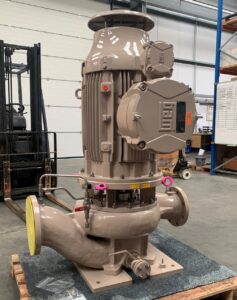Power Plant FGD Pumps Are a Fast Growing Segment in the Pump Industry
According to the McIlvaine Company the power industry has been on a spending spree for new coal-fired power plants. Led by China this spree has finally peaked but will remain at a high level thanks to India, Vietnam and Indonesia which are embarked on ambitious programs.
Total purchases of pumps by the power industry will grow modestly from $3 billion this year to $3.2 billion in 2020. Centrifugal pumps will account for two-thirds of the purchases.
Eighty percent of the pump purchases for the power industry will be made by less than one hundred corporations. PLN in Indonesia will install more new coal-fired boilers than all the utilities in Europe and the U.S. combined. Electricity Vietnam (EVN) will build twice as many as PLN. Several Indian utilities will also build large numbers of new plants.
Sales in Asia will exceed other continents due to both the quantity of new power generation and the choice of fuel. Most new capacity in Asia will be coal-fired where in the U.S., the new capacity will be gas-fired. Coal generators spend three times as much for pumps compared to gas turbine power plants. Pumps are used for cooling water, ultrapure water, steam, FGD recycling slurry and wastewater treatment.
The fastest growing segment of the market has been pumps for flue gas desulfurization (FGD). The reason is that FGD systems are being installed in many older power plants as well as most new ones.
Seventeen coal-fired power plant operators have purchased FGD pumps for 725,000 MW of coal-fired boilers. This represents 56 percent of the total installed capacity. The selection of pumps is typically jointly made by the owner and the supplier. The supply of FGD systems is also concentrated with just nine companies accounting for 45 percent of the total. Suppliers of FGD pumps can focus on less than one hundred companies to address 90 percent of the available market.
Over the next five years, 318,000 MW of FGD systems and pumps are forecast to be installed on new plants. The five largest purchasers are expected to purchase 33 percent of the total. Twenty companies are expected to purchase 75 percent of the total in terms of MW and total dollars. New players in Vietnam and Indonesia plus large owners in China will be the main buyers. So concentration of expenditures in the top one hundred companies will continue.
FGD systems require small pumps to recirculate lime slurry to ball mills and provide mist eliminator wash. Metering pumps are required for chemicals to scaling in the scrubbers and to prevent mercury remissions. Scrubber underflow pumps deliver the gypsum through hydrocyclones to the belt filters. The gypsum wash water is pumped through a wastewater treatment system with additional transfer and metering pumps. The extremely large pumps are used for recirculating the calcium sulfite/sulfate slurries. The FGD recirculating pump requirements can exceed 400,000 gpm for single plant pump orders ranging from $200,000 to $4 million.
The system supplier often selects and furnishes the pump to the power plant. There are less than one hundred suppliers of FGD systems. The Chinese suppliers along with a few U.S. and Japanese companies dominate the FGD market.
A number of Chinese companies have supplied more than 50,000 MW of FGD systems. One supplier has installed more than 100,000 MW. A number of these systems are through licenses with international companies. The analysis is based on the actual supplier rather than the licensor. MHPS, MET, B&W, Alstom and some others have large numbers of systems when both the direct supply and licensed totals are included. The Chinese license payments are dropping as a percentage of revenue. Design improvements are being initiated in China. As a result, suppliers need to deal directly with the Chinese companies and not the licensors.
Many pump companies supply the smaller pumps used in FGD systems but few companies have been able to meet the requirements for recirculation of the slurry. Eight 50,000 gpm slurry pumps are needed to meet the requirements of a large plant. Only a few companies have abrasion and corrosion resistant slurry pumps capable of this flow rate. Weir, KSB and Duechting have been major suppliers but are now being joined by Asian based companies in the pursuit of this market.
McIlvaine has introduced a program incorporating detailed forecasting of total potential sales revenue for each major prospect, project and OEM purchaser of pumps in each industry. The program is based on the detailed forecasting in N019 Pumps World Market. The power segment program also includes 42EI Utility Tracking System.
Source: The McIlvaine Company






